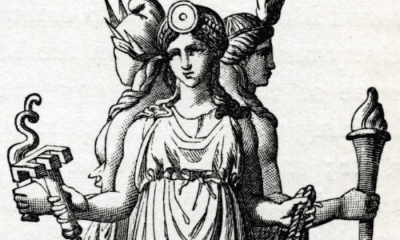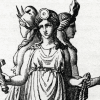Greek
The Cyclops: Greek Mythology’s One-Eyed Monster
If you only know the Cyclops from the Odyssey, you only know part of the story! Read on to learn all about Greece’s legendary one-eyed monsters!
In one of his first adventures of the Odyssey, Homer’s hero encounters an iconic giant. The one-eyed Polyphemus is a prototypical giant who is a barbarous and blasphemous cannibal.
Polyphemus is not the only Cyclops to feature in Greek mythology, however. In fact, he is not even a member of the only race of one-eyed giants.
At least three different versions of the Cyclops exist in Greek legends. While some are ignorant and uncultured, others are skilled inventors who use their abilities to help the gods of Mount Olympus.
The existence of several very different versions of the same creature may seem unusual, but modern interpretations of Greek mythology suggest that there may be a simple explanation for the varied giants of ancient legends.
The Different Types of Cyclops
The Cyclops is one of the most iconic monsters of Greek mythology. The one-eyed giant serves as a memorable and instantly recognizable villain.
The most famous Cyclops appears in the Odyssey. Named Polyphemus, he is one of the first enemies the hero Odysseus encounters on his ten-year long journey home from the Trojan War.
Polyphemus fits the stereotype of a giant in many ways. Brutish and uncultured, he lives in a cave on a secluded island.
When Odysseus and his men find this cave and steal some of the Cyclops’ sheep, Polyphemus responds in brutal fashion. He takes the men captive and eats them, showing contempt for the gods and the laws of nature with his cannibalism.
Odysseus is saved by another common trademark of giants in mythology: the Cyclops’ lack of intelligence.
Tricking Polyphemus into becoming heavily intoxicated, Odysseus blinds him. Because the hero cleverly gave his name as “Nobody,” the two brothers of Polyphemus ignored his cries when he yelled that “Nobody has blinded me!”
The next morning, the wounded giant feels around for his captives but is fooled when they tie themselves beneath his largest rams to slip out undetected.
Polyphemus may be the most well-known Cyclops of Greek mythology, but he represents just one of three known races of one-eyed giants.
He and his brothers were sons of Poseidon. Although they held no reverence for any other gods, Polyphemus asked for his father’s intervention to punish the man who blinded him.
Poseidon’s sons were preceded by two other races of Cyclopes. These were much different than Polyphemus and his brothers.
The first Cyclopes were born before the gods of Olympus. They were sons of Gaia and Uranus, brothers to the Titans.
These three Cyclopes were not dim-witted brutes like Polyphemus. Nevertheless, their father had them imprisoned because of their monstrous appearance.
While locked in Tartarus, the Cyclopes honed their skills as inventors and craftsmen. When Zeus and his brothers freed them, they proved to be valuable allies to the gods instead of their enemies.
They presented the Olympians with valuable items they had made. Zeus received his thunderbolts, Poseidon got a trident that could cause earthquakes, and Hades was given a cloak that made the wearer invisible.
According to Hesiod, these Cyclopes continued to assist the gods in later years. They became assistants to Hephaestus, the smith god, and helped him create the armor, tools, and weapons of the Olympians and the heroes they supported.
The final group of Cyclopes were less well-attested than the others but factored heavily into regional legends. Though not as skilled as the sons of Gaia, they too were not entirely uncultured.
These giants were the builders of the great cities of Mycenae and Tiryns. Their heavy stone walls, it was said, had been fitted in place by Cyclopes who worked as skilled masons.
Even Polyphemus, the monstrous brute of the Odyssey, was not universally seen as a monster.
In later stories, Polyphemus became a romantic figure. His name meant “many songs and legends,” so he was viewed as a musician and poet.
While many stories used this for comedic effect, showing him as unwittingly lacking in talent and grace, others showed the Cyclops in a more positive light.
My Modern Interpretation
There were several different groups of Cyclops in Greek mythology, and each was presented in a different way.
The modern view, and that of many Greek stories, is most influenced by Homer’s depiction in the Odyssey. The unintelligent and uncultured Cyclops he showed became the standard portrayal for all giants in later literature.
This type of monster appears to be the exception rather than the norm in Greek sources, however.
The Cyclopes were not the only type of giant whose depiction was often much more positive than it is thought of today. While the Gigantes were created by Gaia to be enemies of the gods, many were often kings and leaders in foreign countries.
This is at odds with the idea of the giants as universally brutish. Outside of Homer’s story, the Cyclopes in particular were often viewed much more positively.
While modern readers often think of the Cyclopes as a single type of creature, the existence of at least three different groups of these giants shows that the Greek conception of them was far more complex.
In the early 20th century, a palaeontologist proposed a theory that would explain not only how the idea of the Cyclops came to be, but also why different versions of it may have existed in Greek legends.
Austrian scientist Othenio Abel proposed that the image of the Cyclops had been inspired by fossilized mammoth or elephant skulls. The nasal openings of these enormous skulls are much more prominent than the eye sockets, giving the illusion that there is a single massive eye in the center of the face.
These seemingly one-eyed skulls may have been seen by ancient people as evidence of an extinct race with a single eye. Based on the size of mammoth remains, a human-like body would have been several meters tall.
Abel’s theory is still accepted by many as the most logical and likely explanation for how the Cyclops came to be.
Taking the theory farther, it could also explain how different groups of people came to imagine different types of creatures with the same features.
If populations in different areas discovered mammoth or elephant remains, they could have independently developed legends surrounding human-like figures with the same physical attributes. Giants who were brutish and cruel in one area could be helpful and intelligent in another.
The original stories of these giants, in fact, came from different areas of the Greek world. Hesiod was a resident of Asia Minor, far removed from Homer’s homeland of mainland Greece even though they lived at nearly the same time.
Homer saw the Cyclopes as monstrous while Hesiod imagined them as allies of the gods. The people of Mycenae, seeing the enormous limestone boulders of their city’s ancient walls, imagined that the one-eyed giants were the only craftsmen strong enough to fashion such huge structures.
While the Cyclops is an iconic figure, our modern conception of it is largely based on just one source. Individual stories from throughout the Greek world show how the same image can be viewed in many different ways.
In Summary
The most familiar Cyclops, or one-eyed giant, to most modern readers is the character of Polyphemus from the Odyssey. A barbaric and unintelligent monster, he is one of the first foes encountered by Odysseus.
Polyphemus and his brothers were sons of Poseidon, the only god they recognized. While their depiction is famous, however, it is not the only one given for Cyclopes in Greek literature.
Hesiod claimed that the Cyclopes were children of Gaia and Uranus. They created the weapons of the gods, notably Zeus’s thunderbolts and Poseidon’s trident, and were valued allies of the Olympians.
A third group was mentioned as the builders of Mycenae and Tiryns. They used their prodigious strength to place the enormous blocks of stone that made the archaic cities’ walls.
These three types of Cyclops have little in common beyond their appearance. A widely-accepted theory may explain why.
Many people believe that the Cyclopes were inspired by mammoth skulls. Seeming to have a single enormous eye because of their large nasal cavities, these huge skulls seemed like those of enormous men to ancient people.
If such finds inspired the form of the Cyclops, it is possible that it did so more than once. Discoveries in different areas resulted in legendary creatures that looked the same but had very different functions, origin stories, and meanings.



